+ Open data
Open data
- Basic information
Basic information
| Entry | Database: PDB / ID: 1wyw | ||||||
|---|---|---|---|---|---|---|---|
| Title | Crystal Structure of SUMO1-conjugated thymine DNA glycosylase | ||||||
 Components Components |
| ||||||
 Keywords Keywords | HYDROLASE | ||||||
| Function / homology |  Function and homology information Function and homology informationG/U mismatch-specific uracil-DNA glycosylase activity / thymine-DNA glycosylase / G/T mismatch-specific thymine-DNA glycosylase activity / TET1,2,3 and TDG demethylate DNA / chromosomal 5-methylcytosine DNA demethylation, oxidation pathway / pyrimidine-specific mismatch base pair DNA N-glycosylase activity / negative regulation of potassium ion transmembrane transporter activity / protein localization to nuclear pore / : / SUMOylation of nuclear envelope proteins ...G/U mismatch-specific uracil-DNA glycosylase activity / thymine-DNA glycosylase / G/T mismatch-specific thymine-DNA glycosylase activity / TET1,2,3 and TDG demethylate DNA / chromosomal 5-methylcytosine DNA demethylation, oxidation pathway / pyrimidine-specific mismatch base pair DNA N-glycosylase activity / negative regulation of potassium ion transmembrane transporter activity / protein localization to nuclear pore / : / SUMOylation of nuclear envelope proteins / SUMO is proteolytically processed / Negative regulation of activity of TFAP2 (AP-2) family transcription factors / base-excision repair, AP site formation / SUMO is conjugated to E1 (UBA2:SAE1) / negative regulation of delayed rectifier potassium channel activity / PML body organization / negative regulation of DNA binding / SUMO is transferred from E1 to E2 (UBE2I, UBC9) / depyrimidination / negative regulation of action potential / nuclear stress granule / DNA N-glycosylase activity / sodium ion binding / mismatched DNA binding / SUMO binding / small protein activating enzyme binding / Displacement of DNA glycosylase by APEX1 / SUMOylation of DNA methylation proteins / SUMOylation of immune response proteins / SUMOylation of SUMOylation proteins / XY body / regulation of calcium ion transmembrane transport / uracil DNA N-glycosylase activity / Maturation of nucleoprotein / SUMOylation of RNA binding proteins / regulation of cardiac muscle cell contraction / Postmitotic nuclear pore complex (NPC) reformation / Maturation of nucleoprotein / chloride ion binding / negative regulation of protein import into nucleus / SUMOylation of ubiquitinylation proteins / transcription factor binding / ubiquitin-specific protease binding / cellular response to cadmium ion / roof of mouth development / SUMOylation of transcription factors / ubiquitin-like protein ligase binding / SUMOylation of DNA replication proteins / regulation of embryonic development / protein sumoylation / potassium channel regulator activity / Regulation of IFNG signaling / postsynaptic cytosol / nuclear pore / transporter activator activity / negative regulation of DNA-binding transcription factor activity / SUMOylation of DNA damage response and repair proteins / presynaptic cytosol / Transcriptional and post-translational regulation of MITF-M expression and activity / Recognition and association of DNA glycosylase with site containing an affected pyrimidine / Cleavage of the damaged pyrimidine / SUMOylation of transcription cofactors / protein kinase C binding / SUMOylation of chromatin organization proteins / epigenetic regulation of gene expression / transcription coregulator activity / positive regulation of protein-containing complex assembly / SUMOylation of intracellular receptors / base-excision repair / PML body / PKR-mediated signaling / regulation of protein stability / Formation of Incision Complex in GG-NER / protein tag activity / positive regulation of proteasomal ubiquitin-dependent protein catabolic process / Recruitment and ATM-mediated phosphorylation of repair and signaling proteins at DNA double strand breaks / regulation of protein localization / cellular response to heat / double-stranded DNA binding / nuclear membrane / DNA-binding transcription factor binding / damaged DNA binding / nucleic acid binding / protein stabilization / nuclear speck / nuclear body / protein domain specific binding / DNA repair / negative regulation of DNA-templated transcription / ubiquitin protein ligase binding / nucleolus / glutamatergic synapse / enzyme binding / magnesium ion binding / negative regulation of transcription by RNA polymerase II / DNA binding / RNA binding / nucleoplasm / ATP binding / nucleus Similarity search - Function | ||||||
| Biological species |  Homo sapiens (human) Homo sapiens (human) | ||||||
| Method |  X-RAY DIFFRACTION / X-RAY DIFFRACTION /  SYNCHROTRON / SYNCHROTRON /  MOLECULAR REPLACEMENT / Resolution: 2.1 Å MOLECULAR REPLACEMENT / Resolution: 2.1 Å | ||||||
 Authors Authors | Baba, D. / Maita, N. / Jee, J.G. / Uchimura, Y. / Saitoh, H. / Sugasawa, K. / Hanaoka, F. / Tochio, H. / Hiroaki, H. / Shirakawa, M. | ||||||
 Citation Citation |  Journal: Nature / Year: 2005 Journal: Nature / Year: 2005Title: Crystal structure of thymine DNA glycosylase conjugated to SUMO-1. Authors: Baba, D. / Maita, N. / Jee, J.G. / Uchimura, Y. / Saitoh, H. / Sugasawa, K. / Hanaoka, F. / Tochio, H. / Hiroaki, H. / Shirakawa, M. | ||||||
| History |
|
- Structure visualization
Structure visualization
| Structure viewer | Molecule:  Molmil Molmil Jmol/JSmol Jmol/JSmol |
|---|
- Downloads & links
Downloads & links
- Download
Download
| PDBx/mmCIF format |  1wyw.cif.gz 1wyw.cif.gz | 78.8 KB | Display |  PDBx/mmCIF format PDBx/mmCIF format |
|---|---|---|---|---|
| PDB format |  pdb1wyw.ent.gz pdb1wyw.ent.gz | 56.7 KB | Display |  PDB format PDB format |
| PDBx/mmJSON format |  1wyw.json.gz 1wyw.json.gz | Tree view |  PDBx/mmJSON format PDBx/mmJSON format | |
| Others |  Other downloads Other downloads |
-Validation report
| Summary document |  1wyw_validation.pdf.gz 1wyw_validation.pdf.gz | 438.5 KB | Display |  wwPDB validaton report wwPDB validaton report |
|---|---|---|---|---|
| Full document |  1wyw_full_validation.pdf.gz 1wyw_full_validation.pdf.gz | 441.1 KB | Display | |
| Data in XML |  1wyw_validation.xml.gz 1wyw_validation.xml.gz | 14.5 KB | Display | |
| Data in CIF |  1wyw_validation.cif.gz 1wyw_validation.cif.gz | 20.4 KB | Display | |
| Arichive directory |  https://data.pdbj.org/pub/pdb/validation_reports/wy/1wyw https://data.pdbj.org/pub/pdb/validation_reports/wy/1wyw ftp://data.pdbj.org/pub/pdb/validation_reports/wy/1wyw ftp://data.pdbj.org/pub/pdb/validation_reports/wy/1wyw | HTTPS FTP |
-Related structure data
- Links
Links
- Assembly
Assembly
| Deposited unit | 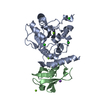
| ||||||||
|---|---|---|---|---|---|---|---|---|---|
| 1 |
| ||||||||
| Unit cell |
|
- Components
Components
-Protein , 2 types, 2 molecules AB
| #1: Protein | Mass: 26177.049 Da / Num. of mol.: 1 / Fragment: central region Source method: isolated from a genetically manipulated source Source: (gene. exp.)  Homo sapiens (human) / Plasmid: pGEX4T-3 / Species (production host): Escherichia coli / Production host: Homo sapiens (human) / Plasmid: pGEX4T-3 / Species (production host): Escherichia coli / Production host:  References: UniProt: Q13569, Hydrolases; Glycosylases; Hydrolysing N-glycosyl compounds |
|---|---|
| #2: Protein | Mass: 11149.545 Da / Num. of mol.: 1 Source method: isolated from a genetically manipulated source Source: (gene. exp.)  Homo sapiens (human) / Plasmid: pT-E1E2S1 / Species (production host): Escherichia coli / Production host: Homo sapiens (human) / Plasmid: pT-E1E2S1 / Species (production host): Escherichia coli / Production host:  |
-Non-polymers , 4 types, 177 molecules 






| #3: Chemical | | #4: Chemical | ChemComp-MG / #5: Chemical | ChemComp-NA / | #6: Water | ChemComp-HOH / | |
|---|
-Experimental details
-Experiment
| Experiment | Method:  X-RAY DIFFRACTION / Number of used crystals: 1 X-RAY DIFFRACTION / Number of used crystals: 1 |
|---|
- Sample preparation
Sample preparation
| Crystal | Density Matthews: 2.12 Å3/Da / Density % sol: 42.06 % | ||||||||||||||||||||||||||||||||||||||||||||||||
|---|---|---|---|---|---|---|---|---|---|---|---|---|---|---|---|---|---|---|---|---|---|---|---|---|---|---|---|---|---|---|---|---|---|---|---|---|---|---|---|---|---|---|---|---|---|---|---|---|---|
| Crystal grow | Temperature: 293 K / Method: vapor diffusion, hanging drop / pH: 8.5 Details: 25% PEG3350, 0.1M Tris, 0.2M Magnesium Chloride, pH 8.5, VAPOR DIFFUSION, HANGING DROP, temperature 293K | ||||||||||||||||||||||||||||||||||||||||||||||||
| Crystal grow | *PLUS Temperature: 20 ℃ / pH: 7.5 / Method: unknown | ||||||||||||||||||||||||||||||||||||||||||||||||
| Components of the solutions | *PLUS
|
-Data collection
| Diffraction | Mean temperature: 100 K |
|---|---|
| Diffraction source | Source:  SYNCHROTRON / Site: SYNCHROTRON / Site:  Photon Factory Photon Factory  / Beamline: BL-6A / Wavelength: 1 Å / Beamline: BL-6A / Wavelength: 1 Å |
| Detector | Type: ADSC QUANTUM 4 / Detector: CCD / Date: Oct 2, 2004 |
| Radiation | Protocol: SINGLE WAVELENGTH / Monochromatic (M) / Laue (L): M / Scattering type: x-ray |
| Radiation wavelength | Wavelength: 1 Å / Relative weight: 1 |
| Reflection | Resolution: 2.1→40 Å / Num. all: 19228 / Num. obs: 19228 / % possible obs: 100 % / Redundancy: 19 % / Biso Wilson estimate: 20.1 Å2 / Rmerge(I) obs: 0.087 / Rsym value: 0.087 / Net I/σ(I): 8 |
| Reflection shell | Resolution: 2.1→2.2 Å / Redundancy: 19.4 % / Rmerge(I) obs: 0.31 / Mean I/σ(I) obs: 2.5 / Num. unique all: 53244 / Rsym value: 0.31 / % possible all: 100 |
| Reflection | *PLUS Lowest resolution: 40 Å / % possible obs: 100 % |
| Reflection shell | *PLUS % possible obs: 100 % / Rmerge(I) obs: 0.35 |
- Processing
Processing
| Software |
| |||||||||||||||||||||||||
|---|---|---|---|---|---|---|---|---|---|---|---|---|---|---|---|---|---|---|---|---|---|---|---|---|---|---|
| Refinement | Method to determine structure:  MOLECULAR REPLACEMENT MOLECULAR REPLACEMENTStarting model: 1MUG, 1EUV Resolution: 2.1→15 Å / σ(F): 0 / Stereochemistry target values: Engh & Huber
| |||||||||||||||||||||||||
| Refine analyze | Luzzati coordinate error obs: 0.24 Å / Luzzati d res low obs: 5 Å / Luzzati sigma a obs: 0.12 Å | |||||||||||||||||||||||||
| Refinement step | Cycle: LAST / Resolution: 2.1→15 Å
| |||||||||||||||||||||||||
| Refine LS restraints |
| |||||||||||||||||||||||||
| LS refinement shell | Resolution: 2.1→2.17 Å
| |||||||||||||||||||||||||
| Software | *PLUS Name: CNS / Version: 1.1 / Classification: refinement | |||||||||||||||||||||||||
| Refinement | *PLUS Highest resolution: 2.1 Å / Lowest resolution: 15 Å / σ(F): 0 / Rfactor obs: 0.205 | |||||||||||||||||||||||||
| Solvent computation | *PLUS | |||||||||||||||||||||||||
| Displacement parameters | *PLUS | |||||||||||||||||||||||||
| Refine LS restraints | *PLUS
| |||||||||||||||||||||||||
| LS refinement shell | *PLUS Rfactor Rfree: 0.309 / Rfactor Rwork: 0.219 |
 Movie
Movie Controller
Controller




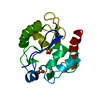
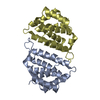
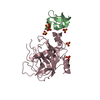
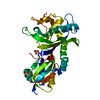

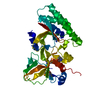
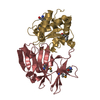


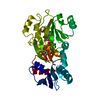

 PDBj
PDBj


















